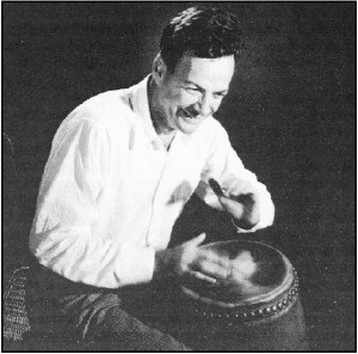From a young age Feynman has shown a great talent for the sciences and an interest of knowledge in general. As a child he showed exceptional skills with engineering and even made his own small house laboratory. He created an alarm system for himself when his parents would leave the house for a prolonged time. As he grew up his interest of learning grew with him, as he became interested in physics and theoretical mathematics. He got his undergraduate degree at the Massachusetts Institute of Technology and then continued his graduate degree at Princeton. After this he spent a good deal of time researching at CalTech and met his first wife Arline Greenbaum who soon died of Tuberculosis. He married again in 1952 to Mary Louise Bell but it was a short-lived and unsuccessful marriage. Then he married Gweneth Howarth, who shared his passion for enthusiasm and lively adventures. They remained married and had two children, a son and a daughter, until Feynman died in 1988.

Among a love of science, Feynman had a love for life, and all things he could learn from anyone willing to teach him. He was an avid dancer and loved to play drums. He was known to experiment with drugs and think about his research in topless bars because he said they helped him to clear his mind.
The most outrageous things happen to this man, or rather he MAKES them happen, and he has a lot to teach us about the role of a playful spirit in creativity and innovation. He continually makes the point that when he stopped having fun with ideas just for the sake of having fun, he lost his edge. He shares some wonderfully crazy tales about drumming on Indian drums in Los Alamos, and about learning the frigideira in the samba bands of Brazil, and his collaboration on a “Caribbean ballet” danced entirely to percussion, that eventually made its way to Paris. He particularly enjoyed learning Watutsi and Nigerian rhythms from Africa and studied with anyone “who would have him as a student”.
The most outrageous things happen to this man, or rather he MAKES them happen, and he has a lot to teach us about the role of a playful spirit in creativity and innovation. He continually makes the point that when he stopped having fun with ideas just for the sake of having fun, he lost his edge. He shares some wonderfully crazy tales about drumming on Indian drums in Los Alamos, and about learning the frigideira in the samba bands of Brazil, and his collaboration on a “Caribbean ballet” danced entirely to percussion, that eventually made its way to Paris. He particularly enjoyed learning Watutsi and Nigerian rhythms from Africa and studied with anyone “who would have him as a student”.